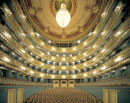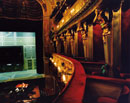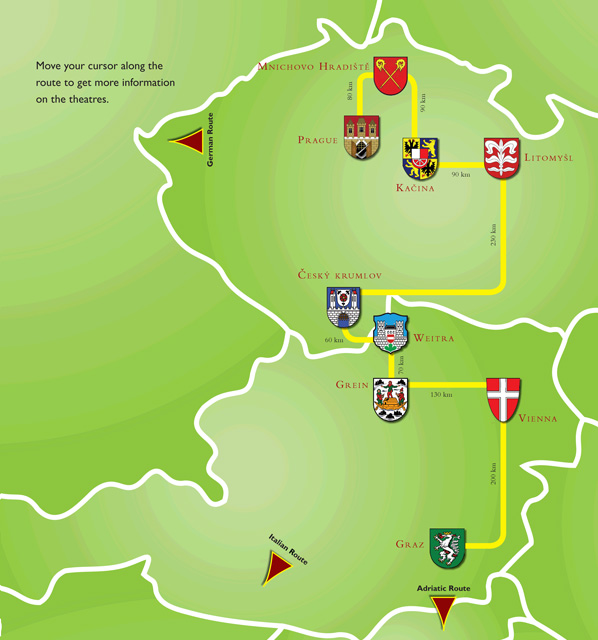 Estates Theatre
Estates Theatre
One of the oldest European theatres operating continuously since its inauguration. It was constructed in 1781–1783 by the imperial court architect Anton Haffenecker for count Franz
Anton Nostitz-Rieneck, the most important royal official in Bohemia. The theatre opened on
21st April, 1783 as "Count Nostiz' National Theater." After being sold to the estates, the theatre was renamed "Estates Theatre" in 1798; it also carried other names before it returned to this one in
1991. Mozart created two operas for Prague which premiered in this theatre: "Don Giovanni" (1787) and "La Clemenza di Tito" (1791). In 1859, one storey was added to the building and an extra gallery in the now higher auditorium; in 1882, the auditorium was redecorated in the present style. Since 1920, the Estates Theatre has been the second stage of the National Theatre.
Stavovské divadlo ∙ Ovocný trh 1 ∙ 110 00 Praha 1 ∙ Czech Republic ∙ Tel.: +420 224 901 448 ∙ E-mail:dotazy@narodni-divadlo.cz ∙ www.narodni-divadlo.cz
Visits: on appointment with Ms Vladislava Bruderová ∙ Tel.: +420 224 902 231 ∙ E-mail: v.bruderova@narodni-divadlo.cz
Tourist information
Pražská informační služba
Tel.: +420 221 714 714
pis@pis.cz
www.praguewelcome.cz
 Palace Theatre
Palace Theatre
The enchanting palace of Mnichovo Hradiště acquired its present form in 1697–1703. In 1833, the reigning count Waldstein hosted an extraordinary event: the meeting of the sovereigns of the Holy
Alliance, i.e. the Austrian emperor Francis I, Czar Nicoals I and the Prussian crown prince Frederick William. On this occasion, the Estates Theatre company from Prague performed in the new palace theatre. This 1833 theatre has been preserved, complete with its simple stage technology, part of the original lighting, the stage decorations and a large collection of costumes. It was opened to the public in 1999 after a restoration campaign. Part of the guided tour of the theatre is a new exhibition commemorating the meeting of the Holy Alliance, also featuring some of the theatrical costumes and props.
Zámecké divadlo ∙ Zámek Mnichovo Hradiště ∙ V Lipách 148 ∙ 295 01 Mnichovo Hradiště ∙ Czech Republic ∙ Tel.: +420 326 773 098 ∙ E-mail:mhradiste@stc.npu.cz ∙ www.mnichovo-hradiste.cz
Visits: guided tours Sat–Sun 09:00–15:00 (April & Oct) ∙ Tue–Sun 09:00–16:00 (May–Sept) ∙ closed Nov–Dec ∙ on appointment only (Jan–March)
Tourist information
Městské informační centrum
Tel.: +420 326 776 739
mic@mnhradiste.cz
www.mnhradiste.cz/mesto/mic
 Palace Theatre
Palace Theatre
Kačina Palace, one of the most beautiful Classicist buildings in the Czech Republic, was designed for count Jan Rudolf Chotek by the German architect Ch. F. Schuricht in 1796 and erected in 1806–22, with additional designs by J. P. Jöndl.
The castle theatre is located in a pavilion at the end of the north wing, together with an unfinished castle chapel. The theatre, too, remained incomplete for a long time and was inaugurated only in 1851. It hosted performances of amateur actors from the counts family; Count Rudolf Karel Chotek was also the author of some of the plays. From this period the richly decorated auditorium, part of the stage machinery and some stage decorations have been preserved. The theatre is accessible as
a part of the guided castle tour.
Zámecké divadlo ∙ Zámek Kačina ∙ Svatý Mikuláš 51 ∙ 284 01 Svatý Mikuláš ∙ Czech Republic
Tel.: +420 327 571 170, +420 602 187 700 ∙ E-mail:nzm.kacina@nzm.cz ∙ www.nzm.cz
Visits: guided tours Tue–Sun 09:00–16:00 (May–Sept); Sat–Sun 09:00–16:00 or on appointment
(April & Oct); on appointment only (Nov–March, min. 10 visitors)
Tourist information
Informační centrum města Kutná Hora
Tel.: +420 327 512 378
infocentrum@kutnahora.cz
www.kutnahora.cz
 Palace Theatre
Palace Theatre
Litomyšl Palace, a UNESCO World Heritage, was built in 1567–1581. Two successive palace theatres operated in the 18th century before the still existing one was inaugurated in 1798. Members of the noble Waldstein-Wartemberg family and their friends performed popular high comedies here for the next 50 years, for their own pleasure as well as for the local audience. The theatre has been preserved entirely, including the original stage machinery and lighting equipment. The unique collection of stage decorations created by Josef Platzer (1751–1806), the imperial court painter who worked for theatres in Vienna and Prague, is on show on the second floor of the palace, together with rare musical instruments. The theatre is accessible as part of the guided tour of the palace rooms.
Zámecké divadlo ∙ Zámek Litomyšl ∙ Jiráskova 93 ∙ 570 01 Litomyšl ∙ Czech Republic ∙ Tel.: +420 461 615 067 ∙ E-mail:litomysl@pardubice.npu.cz ∙ www.zamek-litomysl.cz
Visits: guided tours Sat–Sun 10:00–15:00 (April & Oct) ∙ Tue–Sun 10:00–15:00 (May) ∙ Tue–Sun 10:00–16:00 (June & Sept) ∙ Tue–Sun 10:00–17:00 (July & Aug) ∙ closed Nov–March ∙ reservations compulsory for groups of more than 10 persons ∙ open for groups outside the opening hours on appointment
Tourist information
Informační centrum
Tel.: +420 461 612 161
ic@litomysl.cz
www.ticlitomysl.cz
 Castle Theatre
Castle Theatre
The majestic castle complex, part of the UNESCO World Heritage Český Krumlov, has its origins in the 13th century. A castle theatre was built already in the 17th century, during the reign of the Eggenbergs. It was remodelled completely for Prince Josef Adam Schwarzenberg in 1766–1767 by mostly Viennese artists. One of the oldest historic theatres in Europe, it has been entirely preserved in its original state, even including the stage machinery and lighting, stage decorations, props, costumes and the theatre library, all from the 18th century. Following extensive restorations, it reopened for the public in 1996. Every year, some very few performances in the original style offer the opportunity to experience Baroque theatre in the authentic environment. The theatre is open to visitors every day as part of a guided tour.
Zámecké divadlo · Zámek 59 ∙ 380 01 Český Krumlov ∙ Czech Republic ∙ Tel.: +420 380 704 721 ∙ E-mail:ceskykrumlov@budejovice.npu.cz ∙ www.zamek-ceskykrumlov.eu
Visits: guided tours of the theatre daily at 10:00, 11:00, 13:00, 14:00 and 15:00 (May–Oct) ∙ max. 20 persons
Tourist information
Infocentrum Český Krumlov
Tel.: +420 380 704 622
info@ckrumlov.cz
www.ckrumlov.cz/infocentrum
 Palace Theatre
Palace Theatre
Not far from the Austrian-Czech border the town of Weitra sits on a hill. It was built 1201–1208 by Hadmar II of Kuenringen as a castle and town complex. Around 1600 the castle was transformed into a Renaissance palace by the imperial court architect Pietro Ferrabosco. Here one can spend a whole day, wandering through the palace museum, the brewery museum, the permanent exhibition on the Iron Curtain and: the palace theatre.
The Fürstenberg family who had been residing here since 1606, built the theatre already in the 18th century. In 1885, Count Egon Eduard of Fürstenberg gave it its present form. It is a typical rectangular hall theatre with a royal box at the far end, elegantly decorated in shades of white and gold by the Viennese architect A. Führer.
Also worth seeing are the historical town centre, the medieval city walls and the textile museum.
Schloss Weitra ∙ 3970 Weitra ∙ Austria ∙ Tel: +43 (0)2856 3311 ∙ E-mail:schloss.weitra@aon.at ∙ www.schloss-weitra.at
Visits: Wed–Mon 10–17:30 Uhr (May–Oct) ∙ guided tours for groups all year round on appointment
Tourist information
Gästeinformation Weitra
Tel.: +43 (0)2856 2998
info@waldviertel.incoming.at
www.weitra.at
 Historic Municipal Theatre
Historic Municipal Theatre
The Municipal Theatre in Grein on the banks of the river Danube is the oldest preserved bourgeois theatre in Austria. Enthusiastic amateur players installed it in the city granary in 1791 for their own productions and for touring professional troupes. Access is through the adjoining old town hall (built around 1563), today a museum, complete with the historic jail from which the convicts had a good view of the action on the stage. The theatre has also preserved the original seating in the stalls area where each seat could be locked by the subscribers to prevent other people using it.
In summer time, plays are being performed by professionals during the "Grein Summer Festival" (Sommerspiele Grein), whereas the amateur actors show their productions in November.
Also worth seeing are the historic city centre, the gothic parish church and Grein Castle.
Historisches Stadttheater · Stadtplatz 7 · 4360 Grein · Austria ·
Tel. theatre management: +43 (0)7268 7730 · www.stadttheater-grein.at
Info&tickets: Grein Tourist Information · Tel.: +43 (0)7268 7055 · E-mail: info.grein@oberösterreich.at
Visits: Mon–Sat 9–12 and 14–18, Sun 14–16 (May–Oct); guided tours every day, group tours on appointment
Tourist information
Tourismusverband Grein
Tel.: +43 (0)7268 7055
info.grein@oberoesterreich.at
www.grein.info
 Theater an der Wien
Theater an der Wien
The "Theater an der Wien" was commissioned by Emanuel Schikaneder, Mozart's librettist and
first Papageno, in 1801. For the next 200 years, it was the focus of the most important achievements in Austrian theatre. Beethoven's "Fidelio", Nestroy's popular comedies with songs, the masterworks of the Golden and the Silver Operetta (e.g. "The Bat" by Strauß and "The Merry Widow" by Lehár) and finally the Austrian long-running musicals "Elisabeth" and "Mozart"– they all had their world premiere here. The auditorium presents itself in a design from around 1840, with a richly populated painted curtain from 1864. Since 2006, the "Theater an der Wien" has been dedicated to opera again, showing unusual opera productions all year round in a stagione system.
Theater an der Wien ∙ Linke Wienzeile 6 ∙ 1060 Wien ∙ Austria ∙
Tickets: +43 (0)1 588-85 ∙ Tel. infos: +43 (0)1 588-30-660 ∙ E-mail: oper@theater-wien.at
www.theater-wien.at/index.php/de/fuehrungen1 ∙
www.youtube.com/user/theateranderwien ∙ www.facebook.com/TheateranderWien
Visits: guided tours regularly (see website for dates) ∙ guided tours for groups on appointment
Tourist information
Tourist-Info Wien
Tel.: +43 (0)1 24 555
info@wien.info
www.wien.info
 Opera House
Opera House
The Graz opera house is one of the most beautiful opera houses in Europe. On the Emperor Route, it is also the shining example of a theatre by Fellner & Helmer, the famous duo of architects during the Austrian monarchy who built nearly 50 theatres. Inaugurated in 1899, the opera house features feudal foyers in the style of Fischer von Erlach and a spledid auditorium that combines Italian boxes with French balconies. Although it seats 1200 spectators, everyone is close to the action on stage. About 200 performances are offered every year, ranging from opera, operetta and musical to dance and concerts.
Located at the popular Emperor Josef Square just off the historic city centre, the opera house is the perfect starting point for a tour of the UNESCO World Heritage Graz city centre and Eggenberg Palace.
Oper Graz · Kaiser-Josef-Platz 10 · 8010 Graz · Austria · Tel.: +43 (0)316 8008 1234 ·
E-mail: oper@oper-graz.com ∙ www.oper-graz.com ∙ www.facebook.com/OperGraz
Visits: guided tours every first Saturday of the month at 17:00 (Sept–June) and on appointment
Tourist information
Graz Tourismus
Tel.: +43 (0)316 8075-0
info@graztourismus.at
www.graztourismus.at
 Playhouse
Playhouse
A theatre like a mosaic of 250 years: the playhouse opened in 1776 as "Estates Theatre", supported by the estates of the city and the region. The façade still dates from this period whereas the interior was destroyed in a fire in 1823. The classicist auditorium dates from 1825, when the rebuilt theatre opened again. It is the only preserved example in Austria of an Italian style theatre (with boxes up to the ceiling). In 1964, after refurbishment, it opened for the third time–this time with foyers and staircases from the 1960s. The auditorium had been overhauled, too, and now every visitor can test whether he can see what is 1825 and what is 1964. The productions on stage are clearly from our time, as one can find every other day.
Schauspielhaus Graz GmbH · Hofgasse 11 · 8010 Graz · Austria · Tickets: +43 (0)316 8000 ·
E-mail:tickets@buehnen-graz.com
www.schauspielhaus-graz.com
Visits: on appointment ∙ E-mail: presse-sh@schauspielhaus-graz.com
Tourist information
Graz Tourismus
Tel.: +43 (0)316 8075-0
info@graztourismus.at
www.graztourismus.at
The Emperor Route |
The Emperor Route connects the most interesting historic theatres in the Czech Republic and Austria – two parts of one state during the Habsburg Monarchy.

The route starts in Graz, a city with two major historic theatres. With the beautiful building of the Opera (1899), we are being introduced to the works of the Viennese architects Ferdinand Fellner and Hermann Helmer. They built more than 40 theatres throughout the Monarchy and Germany between 1870 and1910 and thus became synonymous with the theatre architecture of this period.
Also in the city stands the Playhouse. It opened in 1776, was rebuilt in 1823 and saved in the 1960s – a mosaic of three clearly defined styles.
The rich theatrical life in Vienna is represented by the Theater an der Wien (1801) where many important events in Austrian theatre history took and still take place. Further up the Danube, we find the oldest preserved bourgeois theatre in Austria, the theatre in Grein, built by local amateur actors
in 1791. Near the border with the Czech Republic, the palace theatre (1885) in the Fürstenberg's castle at Weitra introduces us to the world of private aristocratic theatre that
had been spreading from Vienna to palaces in the whole Monarchy.
The Emperor Route continues in the Czech Republic with a wealth of these aristocratic theatres. A real jewel is the castle theatre (1768) in Český Krumlov, preserved in its original state, including the ready for use stage machinery, stage decorations, props and costumes, all from the 18th century. In the Renaissance palace of Litomyšl we find the second oldest palace theatre (1798) as
well as a collection of stage decorations created around 1800 by Josef Platzer, the famous Viennese theatre painter.
Kačina palace, built 1806–1822, is one of the most beautiful Classicist buildings in the Czech Republic, complete with a palace theatre that opened in 1851, whereas the palace theatre in Mnichovo Hradiště owes its existence to a meeting of the three emperors of the Holy Alliance in 1833. Here, too, a large number of original equipment and costumes have been preserved.
The grand finale of the Emperor Route is the oldest operating professional theatre in the country, the Estates Theatre (1783/1859) in Prague, a symbol of the rich tradition of Czech and German theatre in the 18th and 19th century.
See the theatres also on film!
The Emperor Route has its own channel on YouTube, where a film on each theatre is being published by and by. Just click on this YOUTUBE link to view the films. You will hear all explanations in the films in Czech, but you can chose English subtitles in the menu. Enjoy!
PDF to download: Emperor-Route
With the support of the Culture Programme of the European Union

 Deutsch
Deutsch English
English Français
Français
